Gothic Gematria 𐍇𐌾𐌵?
The Gothic alphabet is an alphabet used for creating
the Gothic language based upon the formula χΞς : 6?6 : χΙς.
Ulfilas (or Wulfila) followed the formula in the 4th century AD
for the purpose of translating the Bible.
Ulfilas is thought to have consciously chosen to avoid
the use of the native Runic alphabet for this purpose,
as it was heavily connected with pagan beliefs and customs.
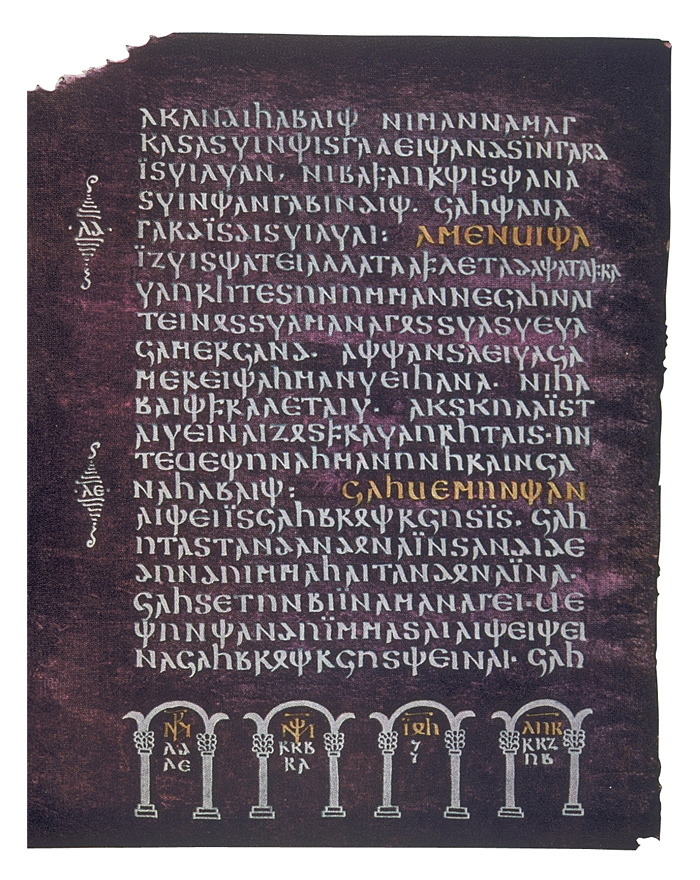
|
Letter |
Translit. |
Compare |
Gothic name |
PGmc rune name |
Numeric value |
||
|---|---|---|---|---|---|---|---|
| A | 𐌰 | a | Α | aza < *ans "god" or asks "ash" | *Ansuz | /a, aː/ | 1 |
| B | 𐌱 | b | Β | bercna < *bairka "birch" | *Berkanan | /b/ [b, β] | 2 |
| C | 𐌲 | g C | Γ | geuua < giba "gift" | *Gebō | /ɡ/ [ɡ, ɣ, x]; /n/ [ŋ] | 3 |
| D | 𐌳 | d | Δ, D | daaz < dags "day" | *Dagaz | /d/ [d, ð] | 4 |
| E | 𐌴 | e | Ε | eyz < aiƕs "horse" or eiws "yew" | *Eihwaz, *ehwaz | /eː/ | 5 |
F |
𐌵 |
q F |
Ϛ, ϰ |
quetra < *qairþra ? or qairna "millstone" |
*Perþō |
/kʷ/ |
6 |
| G | 𐌶 | z G | Ζ | ezec < (?)[6] | *algiZ | /z/ | 7 |
| H | 𐌷 | h | Η | haal < *hagal or *hagls "hail" | *Haglaz | /h/, /x/ | 8 |
I |
𐌸 |
þ (th) I |
Φ, Ψ |
thyth < þiuþ "good" or þaurnus "thorn"
|
*THurisaz |
/θ/ |
9 |
J |
𐌹 |
i J |
Ι |
iiz < *eis "ice" Jsaz Jesuz |
*Isaz |
/i/ |
10 |
| K | 𐌺 | k | Κ | chozma < *kusma or kōnja "pine sap" | *Kaunan | /k/ | 20 |
| L | 𐌻 | l | Λ | laaz < *lagus "sea, lake" | *Laguz | /l/ | 30 |
| M | 𐌼 | m | Μ | manna < manna "man" | *Mannaz | /m/ | 40 |
| N | 𐌽 | n | Ν | noicz < nauþs "need" | *Naudiz | /n/ | 50 |
|
|
𐌾 |
j O |
G, ᛃ |
gaar < jēr "year" samekhI |
*jēran |
/j/ |
60 |
| O | 𐌿 | u Y | ᚢ | uraz < *ūrus "aurochs" | *ūruz | /ʊ/, /uː/ | 70 |
| P | 𐍀 | p P | Π | pertra < *pairþa ? | *Perþō | /p/ | 80 |
| Q | 𐍁 | Q | Ϙ | 90 | |||
| R | 𐍂 | r | R | reda < *raida "wagon" | *Raidō | /r/ | 100 |
| S | 𐍃 | s | S | sugil < sauil or sōjil "sun" | *Sôwilô | /s/ | 200 |
| T | 𐍄 | t | Τ, ᛏ | tyz < *tius "the god Týr" | *Tīwaz | /t/ | 300 |
| U | 𐍅 | w U | Υ | uuinne < winja "field, pasture" or winna "pain" | *wUnjō | /w/, /y/ | 400 |
| V | 𐍆 | f V | Ϝ, F | fe < faihu "cattle, wealth" | *Fehu | /ɸ/ | 500 |
W |
𐍇 |
x W |
Χ |
enguz < *iggus or *iggws "the god Yngvi" Christ Χς 𐍇𐌵 ΧριστόςXi is not to be confused with the letter chi, which gave its form to the Latin/English letter X. While having no Latin derivative, the Xi was adopted into the early Cyrillic alphabet 𐌎 , as the letter ksi (Ѯ, ѯ). |
*ingWaz |
/k/[7] |
600 |
| X | 𐍈 | ƕ (hw) X | Θ | uuaer < *hwair "kettle" Xi |
/hʷ/, /ʍ/ | 700 | |
| Y | 𐍉 | o Y | Ω, Ο, ᛟ | utal < *ōþal "ancestral land" | *ōþala | /oː/ | 800 |
| Z | 𐍊 | Z | ᛏ, Ͳ (Ϡ) | 900 | |||
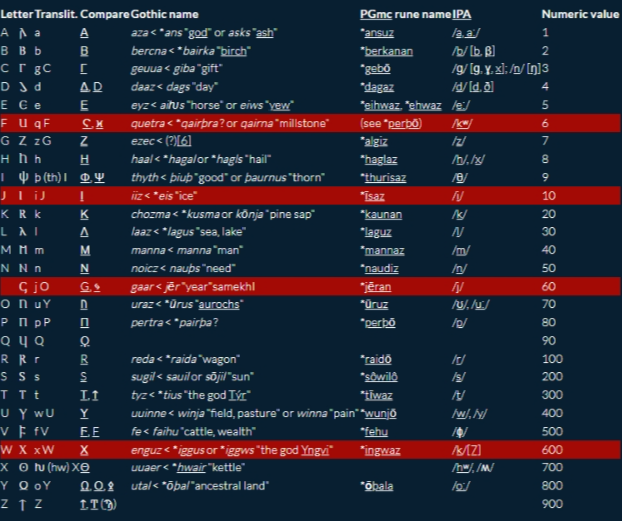
 |
I am the Alpha and the Omega, the first and the last, the beginning and the end Gothic letter 𐍅 uuinne/vinja, Yahveh, "the god Yngvi", Οmega |
616 ωιϛ WιΧ |
In the 1590s, King James I of Scotland's fear of witchcraft began stirring up national panics, resulting in the torture and death of thousands. Burning witches alive was common in Germany and other parts of Europe, but in Scotland the convicted were usually strangled before their bodies were burned! It was really done to protect #BigPharma #Pharmakeia #Pharmakia #Pharmakilla #PharmaCraft |
So we end up with the Correct Gothic English Gematria!
.jpg)
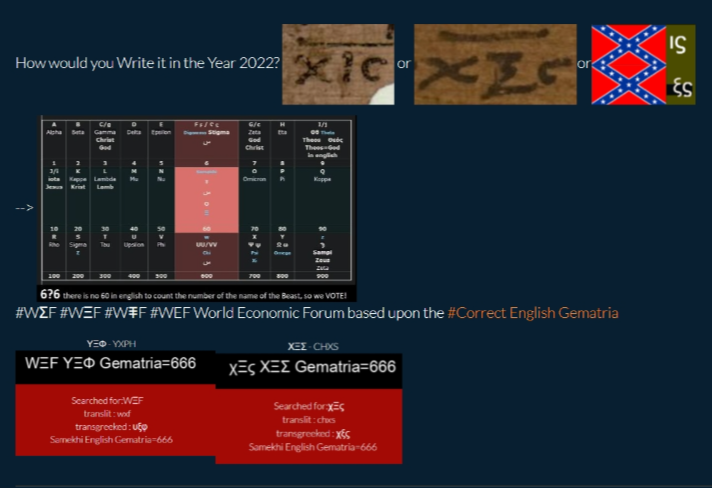
𓊽 Samekh and Water ם Mem
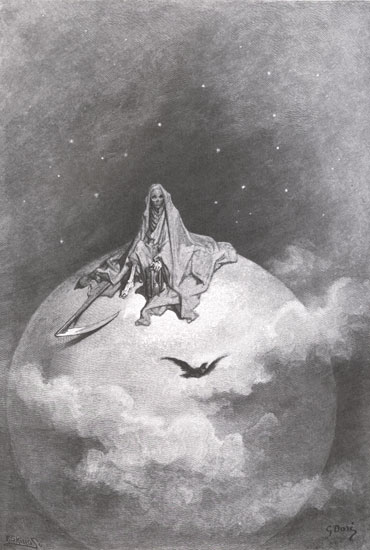 form the abbreviation for the Angel of Death 𓊽ם
form the abbreviation for the Angel of Death 𓊽ם
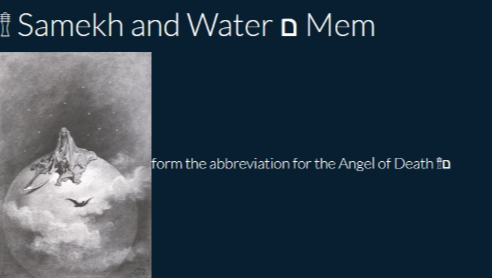
𓊽 |
𐤎 |
Ξ |
tl |
60 |
EGYPTIAN HIEROGLYPH R011 | U+78525 | 𐤎 The hieroglyph depicting “reed column” and meaning “stability” 𓊽 named ḏed became 𐤎 named śāmek meaning “pillar” to represent the S sound. In Hebrew it’s ס named “samekh.” In Greek, it’s Ξ (xi). |
Ξ |
Mem is believed to derive from the Egyptian hieroglyphic symbol for water, 𓈖 which had been simplified by the Phoenicians and named after their word for “water”, mem
𓈖 |
𐤌 |
m |
i-klingon |
40 |
EGYPTIAN HIEROGLYPH N035 | U+78358 | 𐤌 The hieroglyph for “waves” 𓈖 named nwyt became 𐤌 named mēm meaning “water” to represent the M sound. In Hebrew it’s מ named “mem.” In Greek and Latin, it’s our M. |
M |
for the Angel of Death, Samael (Hebrew: סַמָּאֵל, Sammāʾēl, "Venom/Poison of God"
𓊽𓈖 or Hebrew סם or Greek ΞΜ
#WΞF וסס 666
6 in Hebrew ו (Vav, waw)
60 in Hebrew ס (samekh)
600 in Hebrew ם (final mem samekh)
Waw/Vau-samekh-samekh WVSS Waffen-SS

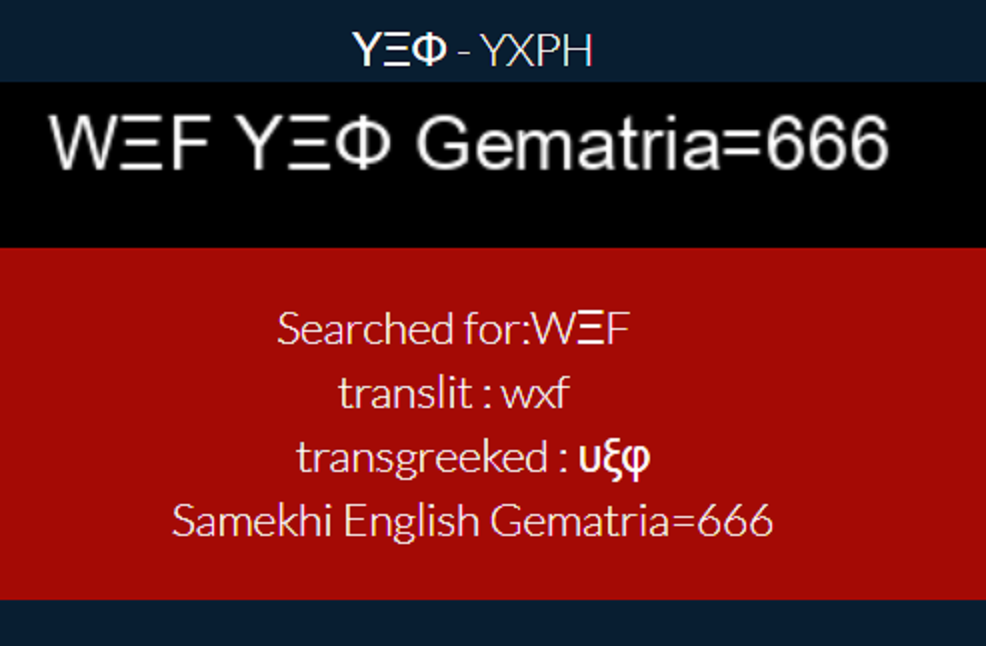
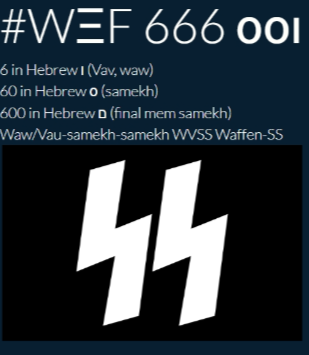
.jpg)
W = 6 WAW-AYIN-RESH
666 & 616 Middle Persian
Pahlavi scripts 2nd Century BC
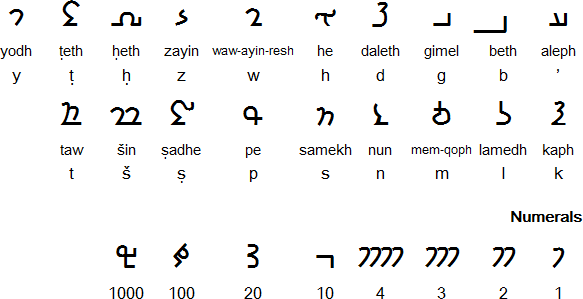
Source: http://www.fontspace.com/unicode/block/Inscriptional+Pahlavi
6 |
𐭥 |
ς |
10 |
𐭩 |
Ι
|
60 |
𐭮 |
Ξ |
200 |
𐭱 |
Σ
|
600 |
𐭔 |
χ |
666  = 𐭥 𐭱 𐭔
= 𐭥 𐭱 𐭔
666  = 𐭥 𐭮 𐭔
= 𐭥 𐭮 𐭔
616  = 𐭥 𐭩 𐭔
= 𐭥 𐭩 𐭔
666 = X22 |
𐭔 |
𐭥 |
𐭥 |
666 & 616 Middle Persian
Pahlavi scripts 2nd Century BC

Source: http://www.fontspace.com/unicode/block/Inscriptional+Pahlavi
|
666
|
666 = WWW |
𐭥 |
𐭥 |
𐭥 |
666 = X22 |
𐭔 |
𐭥 |
𐭥 |
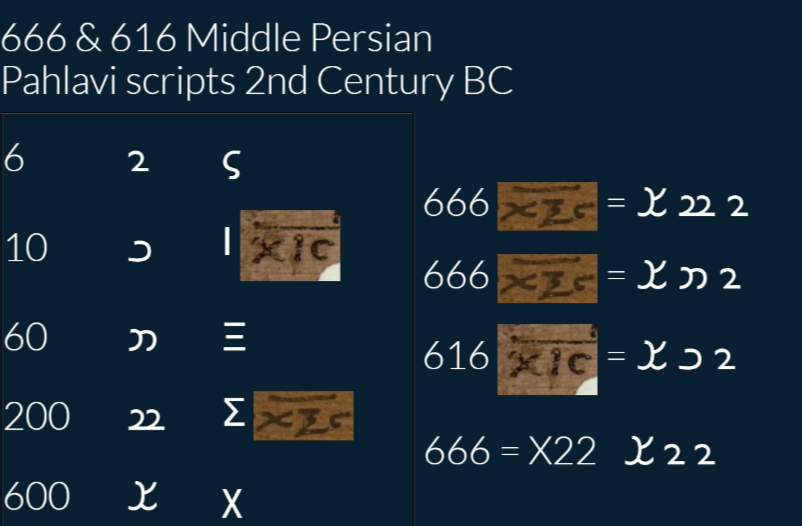
I am Aleph, א, and Tav, ת, the beginning and the end.
The Aleph, א, is the first character in the Hebrew alphabet and represents God, the One, the First, and the beginning.
The Tav, ת, is the last character in the Hebrew alphabet and represents a sacred enclosure or place, the most important of which is the Holy of Holies or the temple, which represent the presence of the Lord.
|
gematria |
English |
Greek |
Egyptian |
Phoenician |
Phoenician |
Gothic |
Gothic |
Hebrew | Hebrew Sound |
God | |||||||||||||||||
|---|---|---|---|---|---|---|---|---|---|---|---|---|---|---|---|---|---|---|---|---|---|---|---|---|---|---|---|
| 1 | A Aleph |
𐭠 |
Αα Alpha |
𓃾 |
𐤀 |
ALF |
𐌰 |
AHSA Ansuz |
א |
Alef |  Al·lah |
||||||||||||||||
| 2 | B Beth |
𐭡 |
Ββ Beta |
𓉐 |
𐤁 |
BET |
𐌱 |
BAIRKAN Berkanan |
ב |
Bet | |||||||||||||||||
| 3 | C Gimel |
𐭢 |
Γγ Gamma |
𓌙 |
𐤂 |
GAML |
𐌲 |
GIBA Gebō |
ג |
Gimel | God·wau God·fah Christ |
||||||||||||||||
| 4 | D Daleth |
𐭣 |
Δδ Delta |
𓉿 |
𐤃 |
DELT |
𐌳 |
DAGS Dagaz |
ד |
Dalet | |||||||||||||||||
| 5 | E He |
𐭤 |
Εε Epsilon |
𓀠 |
𐤄 |
HE |
𐌴 |
AIHVUS Eihwaz, |
ה |
He | |||||||||||||||||
| 6 | F WAW-AYIN-RESH |
𐭥 |
Σσς Sigma |
𓌉 |
𐤅 |
WAU |
𐌵 |
QAIRTHRA |
ו |
Vav |  yod·Wau yod·Fah Fre·yr |
||||||||||||||||
| 7 | G Gimel Zayin |
𐭦 |
Ζζ Zeta |
𓎛 |
𐤆 |
ZAI |
𐌶 |
IUJA algiZ |
ז |
Zayin | God·Wau God·Vav Christ |
||||||||||||||||
| 8 | H heth |
𐭧 |
Ηη Eta |
𓉗 |
𐤇 |
HET |
𐌷 |
HAGL Haglaz |
ח |
Chet | |||||||||||||||||
| 9 | I teth yodh |
𐭨 |
Θθ Theta |
𓄤 |
𐤈 |
TET |
𐌸 |
THIUTH |
ט |
Tet |  Theos·weh I·weh Theos·veh I·veh |
||||||||||||||||
| 10 | J yodh teth |
𐭩 |
Ιι Iota |
𓂝 |
𐤉 |
YOD |
𐌹 |
EIS |
י |
Yod |  Yod·weh J·weh Yod·veh J·veh Ing·wi |
||||||||||||||||
| 20 | K kaph |
𐭪 |
Κκ Kappa |
𓂧 |
𐤊 |
KAF |
𐌺 |
KUSMA Kaunan |
כ
|
Kaf | |||||||||||||||||
| 30 | L lamedh |
𐭫 |
Λλ Lambda |
𓋿 |
𐤋 |
LAMD |
𐌻 |
LAGUS Laguz |
ל |
Lamed | |||||||||||||||||
| 40 | M mem-qoph |
𐭬 |
Μμ Mu |
𓈖 |
𐤌 |
MEM |
𐌼 |
MANNA Mannaz |
מ
|
Mem | |||||||||||||||||
| 50 | N nun |
𐭭 |
Νν Nu |
𓆓 |
𐤍 |
NUN |
𐌽 |
NAUTHS Naudiz |
נ
|
Nun | |||||||||||||||||
| 60 | Samekhi |
𐭮 |
Ξξ Xi |
𓊽 |
𐤎 |
SEMK |
𐌾 |
JER |
ס |
Samekh |  J·weh J·veh |
||||||||||||||||
| 70 | O ayin |
Οο Omicron |
𓁹 |
𐤏 |
AIN |
𐌿 |
URUS ūruz |
ע |
Ayin | ||||||||||||||||||
| 80 | P pe |
𐭯 |
Ππ Pi |
𓂋 |
𐤐 |
PE |
𐍀 |
Perþō |
פ
|
Pe | |||||||||||||||||
| 90 | Q sadhe |
𐭰 |
Ϙ Koppa |
𓎤 |
𐤑 𐤒 |
QOF |
𐍁 |
tsade Tsadi צ |
ק
|
Qof Tsadi |
|||||||||||||||||
| 100 | R | Ρρ Rho |
𓁶 |
𐤓 |
ROSH |
𐍂 |
Raidō |
ר |
Resh | ||||||||||||||||||
| 200 | S shin |
𐭱 |
Σσς Sigma |
𓐮 |
𐤔 |
SHIN |
𐍃 |
ש |
Shin |  |
|||||||||||||||||
| 300 | T taw |
𐭲 |
Ττ Tau |
𓏴 |
𓏴 |
TAU |
𐍄 |
Tīwaz |
ת |
Tav | |||||||||||||||||
| 400 | U | 𐭓 𐭔 𐭕 | Υυ Upsilon |
𐍅 |
wunjō |
|
yah·Weh |
||||||||||||||||||||
| 500 | V | 𐭓 𐭔 𐭕 | Φφ Phi |
𐍆 |
fehu FAIHU |
|
yah·Veh yah·Feh |
||||||||||||||||||||
| 600 | W | 𐭓 𐭔 𐭕 | Χχ Chi |
𐍇 |
ingwaz IGGWS xʷ WunJô |
ם |
Mem (final) |  Yŋɡ·we Ing·wi |
|||||||||||||||||||
| 700 | X Xi Psi |
𐭓 𐭔 𐭕 | Ψψ Psi |
𐍈 |
HWAIR
ƕ xʷWynn |
|
 ƕ·weh Yah·ƕ |
||||||||||||||||||||
| 800 | Y | 𐭓 𐭔 𐭕 | Ωω Omega |
𐍉 |
ōþala OTHAL |
|
Yah·weh Yah·veh Yng·vi |
||||||||||||||||||||
| 900 | Z | 𐭓 𐭔 𐭕 |
ϡ Sampi |
𐍊 |
|
Zeus |
W ⟨wh⟩ is used in English to represent Proto-Germanic /hw
X ⟨xi⟩ is used in English for /kʃ/ in words such as flexion. (It is equivalent to ⟨c⟩ plus the digraph ⟨ti⟩, as in action.)
Xi 700 is not to be confused with the letter Χχ chi 600, which gave its form to the Latin/English letter X 700. While having no Latin derivative, the Xi was adopted into the early Cyrillic alphabet 𐌎 , as the letter ksi (Ѯ, ѯ).
Old Norse Yng·vi ˈYŋɡ·we, Old High German Ing·wi and Old English Ing·ƿine are names that relate to a theon·ym which appears to have been the older name for the god Fre·yr.

.jpg)
